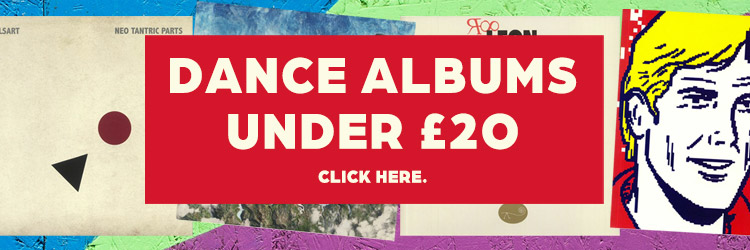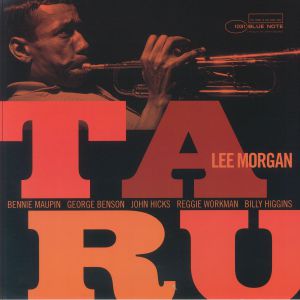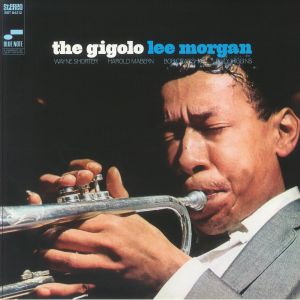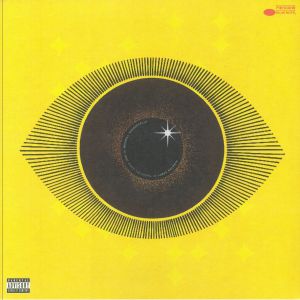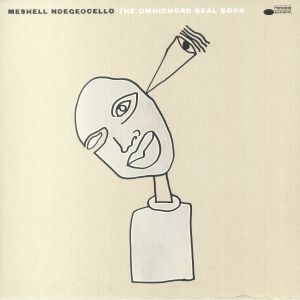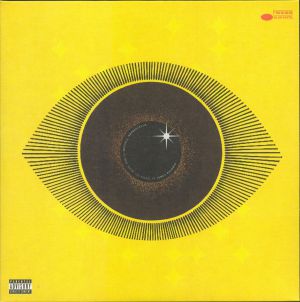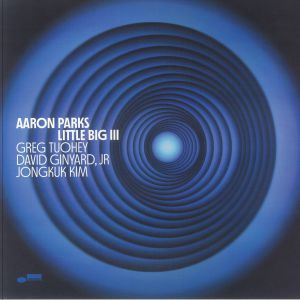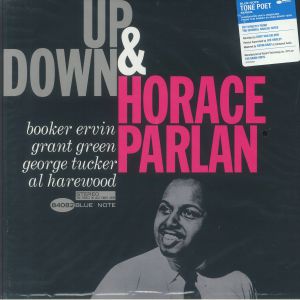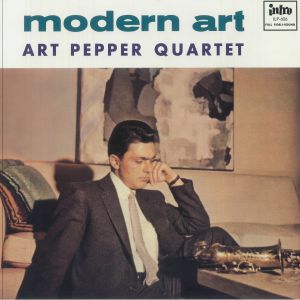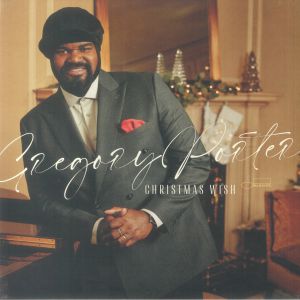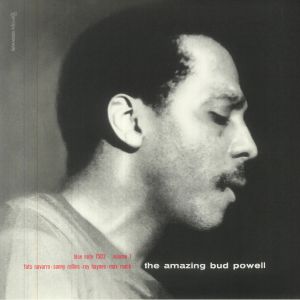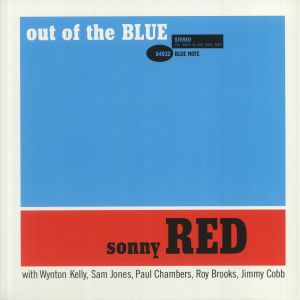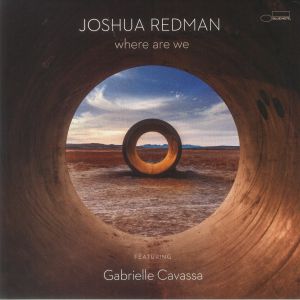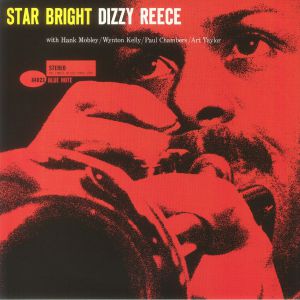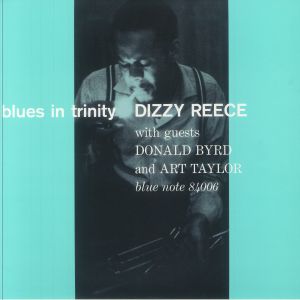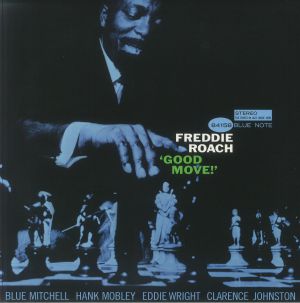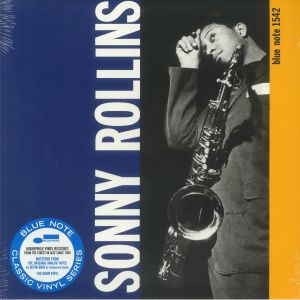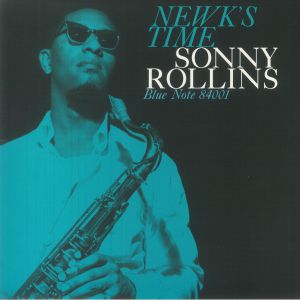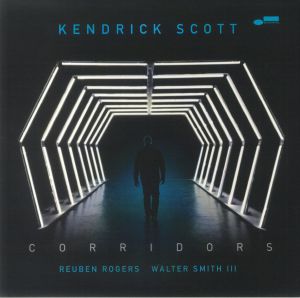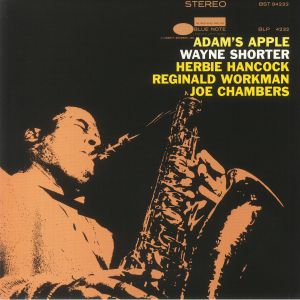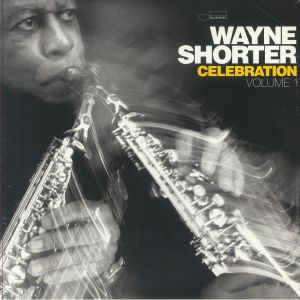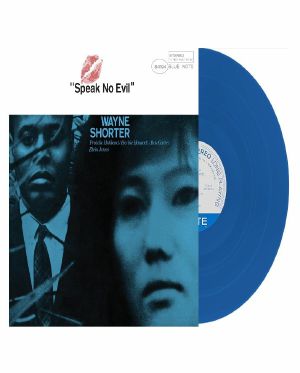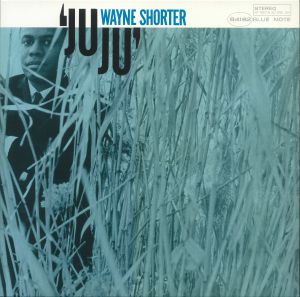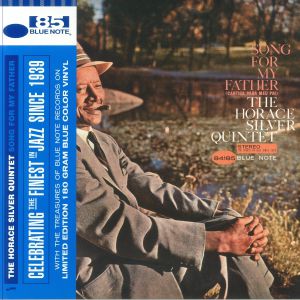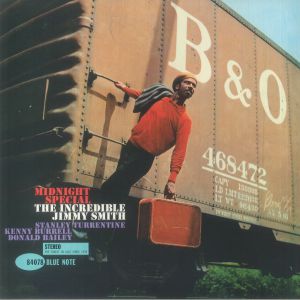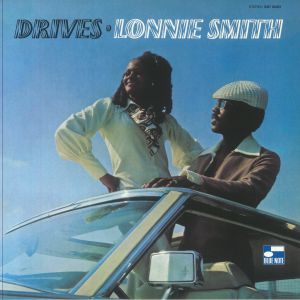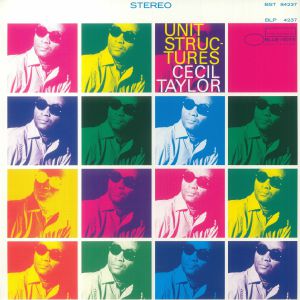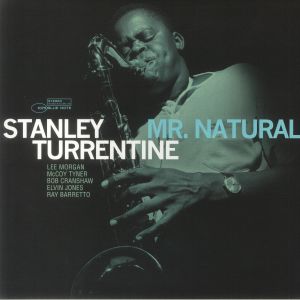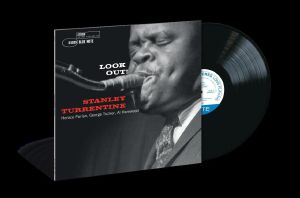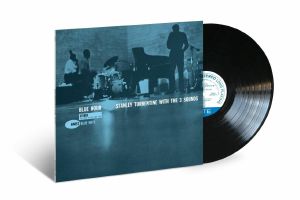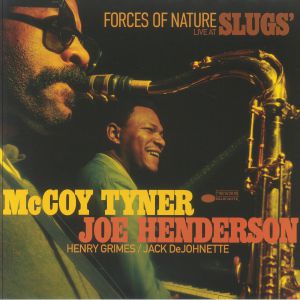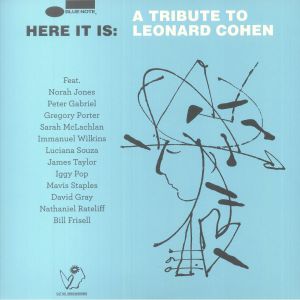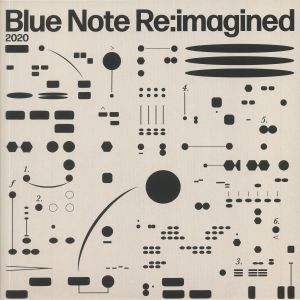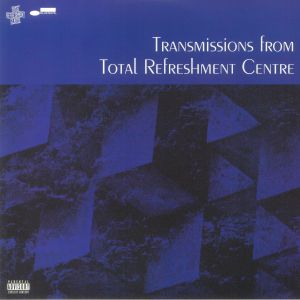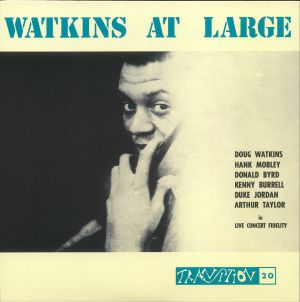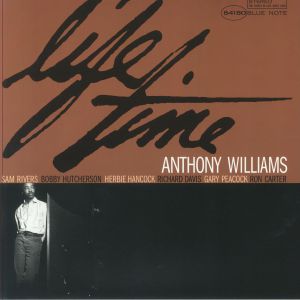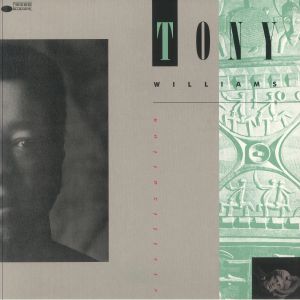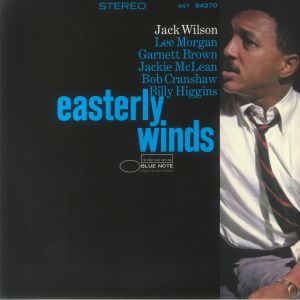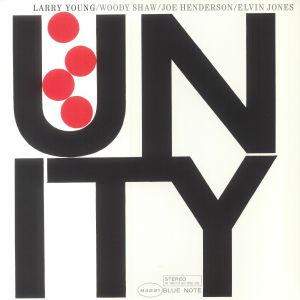Receive new release alerts for Blue Note
Filter
Type
Artist
Release Title
Price
Blue Note Vinyl & CDs
Browse the latest Vinyl & CD releases on Blue NoteSimilar labels:
Taru (Tone Poet Series) (limited gatefold 180 gram audiophile vinyl LP + insert)
Cat: 486442 8. Rel: 01 Aug 24
Jazz
Review: Lee Morgan's Taru, recorded in 1968 but released in 1980, showcases the trumpeter at a pivotal point, exploring a variety of styles with a stellar band. This album is a gem, featuring George Benson's inspired solos on three tracks and Bennie Maupin's debut collaboration with Morgan, setting the stage for future classics like Caramba! and Live at the Lighthouse. The rhythm section, consisting of John Hicks on piano, Reggie Workman on bass, and Billy Higgins on drums, delivers a masterclass in hard bop. The album kicks off with 'Avotcja One,' a modal jazz piece that sets a dynamic tone. 'Get Yourself Together' charges forward with hard bop energy, while 'Haeschen' and 'Taru, What's Wrong With You?' showcase Morgan's ability to craft beautiful ballads. The gospel-tinged 'Dee Lawd' and the funky boogaloo 'Durem' add stylistic variety, making the six-song set a rich display of jazz. This Blue Note Tone Poet Series reissue is a true audiophile delight. Produced by Joe Harley and mastered by Kevin Gray from the original analog tapes, the 180g vinyl pressing at RTI ensures pristine sound quality. The deluxe gatefold tip-on jacket adds a touch of elegance.
… Read morePlayed by: Juno Recommends Jazz
in stock $42.35
Review: Following the runaway success of 1964's The Sidewinder, Alfred Lion continued to record Lee Morgan in pursuit of another boogaloo hit. While subsequent albums like 1965's The Rumproller, The Gigolo, and Cornbread didn't match the same commercial heights, they showcased Morgan's musical prowess. Recorded over two summer dates, The Gigolo features Morgan leading a quintet with Wayne Shorter, Harold Mabern, Bob Cranshaw, and Billy Higgins. This set of swaggering hard bop includes Morgan's originals like the groovy Yes I Can, No You Can't, up-tempo gems such as 'Speedball,' and the stirring 11-minute title track. The album closes with a lush arrangement of 'You Go To My Head,' adding a sensual sway to the collection. This Blue Note Classic Vinyl Edition presents the album in stereo, all-analogue, mastered by Kevin Gray from the original tapes, and pressed on 180g vinyl at Optimal, preserving Morgan's dynamic performances and the quintet's vibrant interplay for contemporary listeners and ardent vinyl enthusiasts.
… Read morePlayed by: Juno Recommends Jazz
in stock $28.51
Search For The Land (Classic Vinyl Series) (180 gram audiophile vinyl LP)
Cat: 583199 4. Rel: 15 Feb 24
Jazz
Review: Lee Morgan's Search For The Land is a soulful exploration of jazz that now gets reissued as part of this classic series son the iconic Blue Note. Released first in 1966, the record showcases Morgan's virtuosity as a trumpeter and composer. With a lineup featuring heavyweights like Wayne Shorter and Herbie Hancock, each track is a journey through intricate melodies and dynamic rhythms. From the exhilarating title track to the introspective 'Melancholee,' Morgan's next level improvisation and emotive phrasing shine throughout. The album's rich textures, buoyant grooves, and evocative solos make it an evergreen gem in the jazz canon and one that captures the essence of Morgan's musical vision with unparalleled depth and allure.
… Read morePlayed by: Juno Recommends Funk, Juno Recommends Jazz
in stock $30.99
No More Water: The Gospel Of James Baldwin (limited gatefold tangerine vinyl 2xLP (indie exclusive))
Cat: 602465 793772. Rel: 15 Aug 24
Jazz
Review: Meshell Ndegeocello's album, No More Water: The Gospel of James Baldwin, is a powerful tribute to the renowned writer and activist, released on his centennial. This visionary work is a blend of musical genres, serving as both a musical experience and a platform for social change. Co-produced by Meshell and guitarist Chris Bruce, the album features collaborations with talented artists like Justin Hicks, Kenita Miller, and Abe Rounds. Additionally, spoken word performances by Staceyann Chin and Hilton Als add depth and meaning to the album. No More Water is a compelling and transformative listening experience that honors Baldwin's legacy and inspires reflection and action. A project that was nearly ten years in the making, all the ingredients are here to make this landmark release that is sure to go down in music history.
… Read morePlayed by: Juno Recommends Jazz
in stock $47.87
Review: "It's a little bit of all of me, my travels, my life," says Meshell Ndgeocello, speaking of her latest album The Omnichord Real Book. Referring to the 'first real book' she ever read - the experience of life after her father's passing - the album is a testament to free-flowing, lived sensoriality in time. An antistatic rip-roar through memory and decay in blue, this is a stunning two-sided jazz-esque album packed with features and far-flung stylisms. In the artist's words, the LP slippily rails against the confines of the word 'jazz' itself. And if you can pull that off, well...
… Read morePlayed by: Juno Recommends Soul
in stock $39.29
No More Water: The Gospel Of James Baldwin (gatefold heavyweight vinyl 2xLP)
Cat: 652150 5. Rel: 01 Aug 24
Jazz
Review: Meshell Ndegeocello's upcoming album, No More Water: The Gospel of James Baldwin, is a profound tribute to the iconic author on the 100th anniversary of his birth. Following her Grammy-winning debut on Blue Note Records, Ndegeocello co-produced this album with guitarist Chris Bruce, enlisting a talented ensemble including vocalist Justin Hicks, saxophonist Josh Johnson and others. The album's first singles, 'Travel' and 'Raise the Roof,"' offer a glimpse into its powerful blend of music and spoken word. With contributions from poet Staceyann Chin and others, Ndegeocello's work transcends mere tribute, offering a transformative experience that is part music, part sermon, part celebration, and part call to action. No More Wate promises to be a genre-defying, spiritually enriching journey that honors Baldwin's legacy while adding a unique musical perspective. This album is poised to be a standout in Ndegeocello's already illustrious career.
… Read morePlayed by: Juno Recommends Jazz
in stock $39.29
Review: This release feels like a collision of worlds, where abstract textures and rhythmic intricacies are forced into a dialogue with more accessible forms of electronic music. The opening track sets a tone of strange, mysterious propulsion, yet never fully gives in to any familiar conventions. Instead, it hints at a narrative unfoldingia journey, almost, where sound and intention coalesce but never fully resolve. It's a slow burn that rewards those who stick around, offering complex layers that reveal themselves gradually. Far from merely experimental, it finds a rare balance between artifice and soul, making each sonic twist feel purposeful and immersive.
… Read more in stock $28.77
Invisible Cinema (Classic Vinyl Series) (gatefold 180 gram vinyl LP)
Cat: 583203 8. Rel: 20 Jun 24
Broken Beat/Nu Jazz
Review: Pianist and composer Aaron Parks made his first Blue Note appearance as a member of Terence Blanchard's band; an outfit akin to The Jazz Messengers in its cultivation of future jazz greats. After appearing on the trumpeter's albums Bounce, Flow, and A Tale of God's Will through the early 2000s, Parks made his own Blue Note debut in 2008 with Invisible Cinema, a striking album that has only grown in its influence across the modern jazz landscape since its release. The band - a quartet featuring the pianist with Mike Moreno on guitar, Matt Penman on bass, and Eric Harland on drums - travelled across new sonic and rhythmic frontiers on this set of Parks' evocative original compositions which were imbued with a cinematic drama and drew inspiration from the likes of Wayne Shorter, Radiohead, Bjork, Meshell Ndegeocello, and more. This first-time vinyl release includes two bonus tracks previously only available in Japan.
… Read morePlayed by: Juno Recommends Broken Beat Nu Jazz
in stock $41.79
Review: Pianist and composer Aaron Parks returns to Blue Note with Little Big III, the third album in a triptych backed by his own band Little Big. Once again, Little Big pack a microcosmic punch for a macrocosmic time, bringing concise, accessible songwriting and vibrant, empathetic playing to a powerfully modern, post-genre concept for improvised music in the 21st Century. From the serene navy blues of 'Delusions' to the flourishingly measured basement bar bravura of 'Ashe', this is a cracking blue jazz album, held together by Parks in fusion with the the unique talents of David Ginyard Jr., Jongkuk Kim and Greg Tuohey.
… Read more in stock $31.83
Review: This Tone Poet Vinyl Edition presents Horace Parlan's quintessential hard bop quintet session. Known for his work with Charles Mingus, Parlan shines alongside George Tucker, Al Harewood, Grant Green, and Booker Ervin. The music swings with an effortless groove, showcasing Parlan's bluesy piano stylings and the band's tight interplay. Mastered from the original analogue master tapes by Kevin Gray, this reissue captures the warmth and vibrancy of the original recording. A must-have for any fan of hard bop and classic Blue Note sounds.
… Read morePlayed by: Juno Recommends Jazz
in stock $39.29
Review: Duke Pearson's 1964 gem Wahoo! is a shining showcase of his skills as a pianist, composer, and bandleader. Writing for a sextet, Pearson brought together an exceptional lineup featuring Donald Byrd on trumpet, James Spaulding on alto sax, Joe Henderson on tenor, Bob Cranshaw on bass and Mickey Roker on drums. The result is a set of evocative originals, like the tender 'Amanda', the mysterious 'Bedouin', and the hard-hitting 'ESP (Extrasensory Perception)'. This Blue Note Classic Vinyl Edition does justice to Pearson's work, offering an all-analog, stereo mix mastered by Kevin Gray from the original tapes. Pressed on 180g vinyl at Optimal, it's got everything an audiophile could hope for. Whether it's the energetic swing of 'Fly Little Bird Fly' or the deeper hues of 'Farewell Machelle', every track radiates Pearson's unmistakable touch, balancing sophistication with soul.
… Read morePlayed by: Juno Recommends Jazz
in stock $30.17
Review: A refined and understated session, this reissue is a masterful example of West Coast jazz, offering a smooth, mellow and introspective listening experience. Recorded between december 1956 and January 1957 in Hollywood, California, this album showed Pepper's signature melodic alto saxophone over a relaxed and fluid quartet setting. The lineup features Russ Freeman on piano, Ben Tucker on bass and Chuck Flores on drums, each contributing to the album's effortlessly cool and unfailingly swinging atmosphere. Unlike the high-energy performances found on Art Pepper Meets the Rhythm Section, Modern Art unfolds at a more leisurely pace, making it a perfect soundtrack for a laid-back evening. The album's bookends, 'Blues In' and 'Blues Out', frame a collection of beautifully arranged pieces, including exquisite renditions of 'Bewitched', 'Stompin' at the Savoy' and 'What Is This Thing Called Love'. One of the true highlights is 'Summertime', a performance filled with emotional depth and intensity, as though Pepper poured his very soul into each note. This Blue Note Tone Poet reissue, produced by Joe Harley and mastered by Kevin Gray from the original analogue tapes, is an essential edition. Pressed with impeccable sound quality, this release does full justice to Pepper's warm, lyrical tone. Whether you're just beginning your jazz journey or a seasoned listener, Modern Art is the type of album that continues to reveal its brilliance with every spin. If you're new to jazz, this album might just make you a fan of the West Coast sound.
… Read morePlayed by: Juno Recommends Jazz
in stock $40.41
Review: Ella Fitzgerald has a spotless discography that is packed with many a classic tunes but for plenty of fans and critics alike, Let No Man Write My Epitaph is one of her ultimate standouts. She recorded the album back in 1960 with backing from the pianist Paul Smith. The album takes its name from the movie in which Fitzgerald starred and hits some truly rare depth of emotional understanding. It helped secure Ella's status as one of the finest translators of the Great American Songbook and now Verve's Acoustic Sounds Series transfers the originals from analog tapes and has remastered them on to 180-gram vinyl complete with deluxe gatefold packaging.
… Read more in stock $30.44
Review: Bebop piano genius Bud Powell made his most enduring recordings as a leader for Blue Note, and was a catalyst for moving the label from the hot jazz on which it was founded, into the modern music made by Powell, Thelonious Monk, Fats Navarro, and others. Powell's 1949 and 1951 quintet & trio sessions were first released in 1952, in the form of the 10" LP The Amazing Bud Powell, and later expanded as The Amazing Bud Powell, Vol. 1, when Blue Note moved to the 12" LP and launched the 1500 series in 1955. The quintet date featured the pianist with the likes of trumpeter Fats Navarro, tenor saxophonist Sonny Rollins, bassist Tommy Potter, and drummer Roy Haynes performing Powell originals such as 'Dance of the Infidels,' 'Wail,' and 'Bouncing with Bud.' The trio date featured bassist Curly Russell and drummer Max Roach joining Powell on the jaunty classic 'Un Poco Loco,' presented here in three evolving takes, along with timeless versions of Powell's 'Parisian Thoroughfare' and Dizzy Gillespie's 'A Night In Tunisia,' as well as showstopping solo piano performance of 'It Could Happen To You.'
… Read more in stock $29.87
Out Of The Blue (Tone Poet Series) (limited gatefold 180 gram audiophile vinyl LP)
Cat: 353818 9. Rel: 01 Apr 22
Jazz
Review: Even though it came on the venerated Blue Note label, Sonny Red's Out of the Blue record is somehow something of an overlooked treasure. Alto sax man Sonny Red only out this one record for the label and recorded it across two separate sessions with piano from Wynton Kelly as well as Sam Jones and Paul Chambers on bass, stickmen Roy Brooks and Jimmy Cobb. This reissue is part of the Tone Poet Series which presses up records on nice heavy wax in deluxe packaging after remastering form the original analogue master tapes so you can be sure it sounds superb.
… Read morePlayed by: Juno Recommends Jazz
in stock $35.15
Review: A wonderfully warm and heartrending new jazz opus from Joshua Redman - Where We Are adds to Blue Note's legacy as standing for "The Finest In Jazz". Over the past three decades, the saxophonist, composer, and bandleader has consistently demonstrated how to honor the music's verities while expanding its reach in contemporary settings. On where are we, Redman's first recording as a Blue Note artist, he delivers one of his most compelling albums to date, in a program featuring typically brilliant supporting partners and (in a first for Redman) built around a dynamic vocalist, Gabrielle Cavassa. With incisive attention to detail and impeccable recordings, this is not one to let pass by.
… Read more in stock $39.29
Review: Originally from Jamaica, Dizzy Reece went on to become a legendary jazz trumpeter from the mid-50s onwards, and Star Bright is surely one of his finest moments. Recorded for Blue Note in 1959, the album features Hank Mobley on tenor sax, Paul Chambers on bass, Art Taylor on drums and Wynton Kelly on piano, and if the hard bop sound is your thing, you really shouldn't be without this album in your life. From the loping opening of 'The Rake' to the sprightly 'Groovesville' and onwards, it's pure magic on the ears, freshly pressed up for an immaculate listening experience.
… Read more in stock $24.63
Review: A transatlantic jazz summit, capturing Jamaican trumpeter Dizzy Reece alongside American legends Donald Byrd and Art Taylor. Recorded in London in 1958, Blues In Trinity marks Reece's Blue Note debut, a vibrant blend of hard bop and soulful melodies and features a stellar lineup including Tubby Hayes on tenor sax, Terry Shannon on piano and Lloyd Thompson on bass. Reece's trumpet shines throughout, his expressive playing and melodic phrasing complemented by Byrd's equally impressive contributions. Highlights include the soulful title track, the dreamy 'I Had The Craziest Dream' and a captivating rendition of Monk's 'Round About Midnight'.
… Read morePlayed by: Juno Recommends Jazz
in stock $39.29
Good Move (Tone Poet Series) (gatefold 180 gram audiophile vinyl LP)
Cat: 550597 3. Rel: 12 Dec 24
Jazz
Review: Freddie Roach's 1963 session is a soul jazz classic that epitomises Blue Note's golden era. With a line-up featuring Blue Mitchell's crisp trumpet lines, Hank Mobley's smoky tenor sax, Eddie Wright's intricate guitar work, and Clarence Johnston's dynamic drumming, the music brims with groove and sophistication. Roach's Hammond B3 organ anchors the ensemble, balancing soulful warmth with technical brilliance. This deluxe reissue, part of the Tone Poet series, features meticulous production by Joe Harley. A timeless gem, now restored for audiophiles and jazz lovers alike.
… Read more in stock $36.25
Review: Sonny Rollins made his Blue Note debut in 1949 with Bud Powell, but returned as a leader in 1956 with Volume 1. This album showcases classic Rollins so has plenty of hard-swinging originals and a tender ballad that perfectly offer up his powerful sound and boundless improvisational skills. The quintet includes Donald Byrd, Wynton Kelly, Gene Ramey and Max Roach who all support Rollins in creating a dynamic blend of jazz. This record solidified Rollins' reputation as a leading figure in the genre, and that is still true to this day.
… Read morePlayed by: Juno Recommends Jazz
in stock $30.99
Review: Jazz great Sonny Rollins is in a romping mood on this album News's Time. This version for Blue Note's Classic Edition has been remastered in all analogue on heavyweight wax. The set list is a varied one that blitzes its way through Broadway show tunes, big pop songs, some special pieces by Miles Davis and Kenny Dorham, and Sonny's own much-loved 'Blues for Philly Joe.' It is an all time classic amongst many from Rollins and one of four he made for this label in the course of just one year.
… Read more in stock $30.99
Review: Kendrick Scott has been holding it down as a leading contemporary jazz drummer in the US for more than a decade, and he returns to Blue Note with a new album after 2019's knockout A Wall Becomes A Bridge. His innate sense of optimism comes through in the music, as he seeks on Corridors to highlight the things that connect us people sharing a world. It is of course a response to the isolation of the pandemic years, but also a deeper reflection on what it means to ride the wave. Working with a pared down trio featuring saxophonist Walter Smith III and bassist Reuben Rogers, the Hoston-based sticksman lays down another striking statement that builds on his ever-progressing legacy.
… Read more in stock $26.29
Review: Now more than 80 years old and onto its umpteenth reissue after the latest was a 75th anniversary edition in 2015, Wayne Shorter's Adam's Apple remains as classic as ever. This Classic Vinyl Series issue is all-analogue and mastered by Kevin Gray from the original master tapes then pressed on 180g vinyl. Next to sax from Wayne himself, Herbie Hancock, Reggie Workman and Joe Chambers joined the ranks to help cook up these serious grooving and cool-cat tunes. It was originally released in 1966 and still stands out as one of his greatest ever albums.
… Read morePlayed by: Juno Recommends Jazz
in stock $31.83
Review: Celebration, Volume 1 is the inaugural release in a series of archival recordings curated by the legendary saxophonist and composer Wayne Shorter before his passing in 2023. This exhilarating 2014 live recording captures Shorter's acclaimed quartet, featuring pianist Danilo Perez, bassist John Patitucci, and drummer Brian Blade, at the Stockholm Jazz Festival in Sweden. The adventurous set includes favorites such as 'Zero Gravity,' 'Smilin' Through,' 'Orbits,' 'Lotus,' and 'She Moves Through The Fair.' Carolina Shorter, in the album's liner notes, recalls how Wayne immersed himself in unreleased music in late 2022, making detailed notes on each track. His excitement was palpable when he first heard the Stockholm concert, exclaiming, "this is the album!" Initially envisioning the collection as Unidentified Flying Objects due to the innovative notes played, Wayne ultimately decided to name it Celebration to honor life. The album is not just a live recording but a vivid celebration of Shorter's enduring legacy and musical vision.
… Read morePlayed by: Juno Recommends Jazz
in stock $39.29
Review: Between 1964-1967 the legendary saxophonist and composer Wayne Shorter created a treasured and deeply influential body of work, among which 1967's Schizophrenia lay. On this meandering but impassioned jazz dedication to an often misunderstood mental state, Shorter arrived at the pinnacle of post-bop and gazed out at the horizons around him, producing one of his most complete and stylistically diverse artistic statements with a sextet of like-minded musical adventurers. James Spaulding on alto saxophone and flute, Curtis Fuller on trombone, Herbie Hancock on piano, Ron Carter on bass and Joe Chambers on drums; all came together to play some of Shorter's most enduring themes, including the unforgettable groove of 'Tom Thumb', the evocative 'Go', and the ballad 'Miyako'.
… Read morePlayed by: Juno Recommends Jazz, DJ ROCCA
in stock $40.95
Speak No Evil (limited 180 gram blue vinyl LP with obi-strip (indie exclusive))
Cat: 587906 7. Rel: 08 Aug 24
Jazz
Review: Wayne Shorter's Speak No Evil, recorded during his tenure with Miles Davis and released on Blue Note, stands as a pinnacle of his solo work. While Shorter's tenure with Art Blakey, Miles Davis, and Weather Report alone would secure his place in jazz history, this album underscores his genius as a bandleader and composer. Blending hard bop with avant-garde influences, Speak No Evil features a potent lineup: Shorter on tenor sax, Freddie Hubbard on trumpet, Herbie Hancock on piano, and Elvin Jones on drums. The album strikes a balance between traditional hard bop and more exploratory sounds. Tracks like the intense, fast-paced title piece 'Speak No Evil' showcase the ensemble's dynamic interplay, while 'Dance Cadaverous' offers a moody, atmospheric contrast with its subtle avant-garde touches. Each composition, penned by Shorter, highlights his exceptional skill as a writer and performer. Speak No Evil is impactful for illustrating Shorter's enduring brilliance in jazz.
… Read morePlayed by: Juno Recommends Jazz
in stock $39.84
Juju
Deluge
House Of Jade
Mahjong
Yes Or No
Twelve More Bars To Go
Review: Wayne Shorter's Juju, featuring McCoy Tyner on piano, Reggie Workman on bass, and Elvin Jones on drums, was recorded at Rudy Van Gelder Studio in August 1964 and released in July 1965, resonating with profound influences from John Coltrane. The album's allure lies not merely in technical strength but in its emotive depth, transcending analytical descriptions. Shorter's tenor saxophone exudes a brooding intensity, marked by sharp tonality and deliberate, weighty phrasing, punctuated by rapid flourishes into higher registers that convey a sense of restrained urgency. His compositions, characterised by hypnotic, repetitive motifs, unfold a richly textured musical adventure. The interplay between Shorter and Tyner on Juju reveals a unique dynamic, distinct from Shorter's collaborations with Herbie Hancock on other Blue Note recordings. The album shows varying ensemble configurations across Shorter's discography, each contributing to its nuanced musical landscape. This Blue Note Classic Series reissue, mastered from the original tapes, preserves the album's timeless appeal.
… Read morePlayed by: Juno Recommends Jazz
in stock $30.99
Song For My Father (reissue) (limited 180 gram blue vinyl LP with obi-strip (indie exclusive))
Cat: 651173 2. Rel: 12 Sep 24
Jazz
Review: A decade into his career, Horace Silver recorded what many consider one of his finest albums at the renowned Van Gelder Studio. Joined by Blue Mitchell, Junior Cook, Gene Taylor, and Roy Brooks, the session marked a key transition for his quintet. This album was released a year before his iconic hit 'Song for My Father,' which was indeed a tribute to his Cape Verdean father. This reissue for the Blue Note Classic series has been remastered by Kevin Gray from the original master tapes so it offers an all-analogue experience and delivers superb sound quality that honours Silver's legacy.
… Read more in stock $39.57
Serenade To A Soul Sister (Classic Vinyl) (gatefold 180 gram vinyl LP)
Cat: 651496 9. Rel: 20 Mar 25
Jazz
Review: An album that stands as one of American jazz pianist Silver's last great albums for Blue Note. Recorded in early 1968 with two mostly different quintets, the album features trumpeter Charles Tolliver, alternating tenor saxophonists Stanley Turrentine and Bennie Maupin, bassists Bob Cranshaw and John Williams and drummers Mickey Roker and Billy Cobham. Silver's rhythmic, economical piano style is often described as funky and nowhere is this more evident than on the album's standout opener, 'Psychedelic Sally'. With its jubilant horn theme and funky Memphis soul-inspired bass riff, the track is a rollicking seven-minute classic that blends 60s funk with 50s bop. The rest of the album maintains a playful spirit. 'Rain Dance' presents a campy, American Indian-style theme, while 'Jungle Juice' offers an exotic, tribal flavour. The warm, loose-swinging title track, 'Serenade to a Soul Sister' and the ethereal 'Kindred Spirits' add depth to the set. The album closes with the gentle piano trio ballad 'Next Time I Fall in Love'. While the first half of the album leans into a bluesy, funky vibe with Turrentine's soulful saxophone, the latter half shifts to a more boppish feel with Maupin, is a different but equally engaging dynamic. Through it all, Silver's philosophy of keeping politics and anger out of his music shines, delivering a joyous and tightly performed soul-jazz classic.
… Read more in stock $29.87
Midnight Special (Blue Note Classic Vinyl Series) (180 gram audiophile vinyl LP)
Cat: 5523659. Rel: 14 Sep 23
Jazz
Review: Blue Note continues to serve up reissues of its most classic albums and this from Jimmy Smith user is one of them. Known for being a legendary player of the Hammond B3 organ, he recorded a couple of soul jazz classics in Midnight Special and Back at the Chicken Shack, both on the same day in April 1960 at the famous Van Gelder Studio. Smith lead the way with his self taught organ skills alongside Stanley Turrentine on tenor saxophone, Kenny Burrell on guitar, and Donald Bailey on drums. This album features the hard hitter 'Jumpin' the Blues' amongst many other gems.
… Read more in stock $24.91
Review: Legendary Hammond organ player Lonnie Liston Smith had a very special run at New York's Jazz Standard in New York in 2017 as part of a celebratory 75th birthday series. The Breathe album captures the magic of the residency with an expanded line-up of talents including Jonathan Kreisberg on guitar, drums from Johnathan Blake, Jason Marshall and John Ellis on saxophone, plus Sean Jones on trumpet and Robin Eubanks on trombone. He recorded his All In My Mind album in the same week and so was in fine form across all of these spaced out jazz sounds. The album is bookended by tracks featuring the one and only Iggy Pop as well as a cover of Donovan's 1966 hit 'Sunshine Superman'.
… Read morePlayed by: Craig Charles Funk And Soul
in stock $30.44
Review: Lonnie Smith's 1970 opus Drives manifests an exhilarating blend of adventure and unyielding grooves. Featuring a stellar lineup with Dave Hubbard on tenor sax and Ronnie Cuber on bari sax, Smith reinterprets classics like 'Twenty-Five Miles' and 'Spinning Wheel' while breathing new life into Miles Davis' 'Seven Steps to Heaven.' This Blue Note Classic Vinyl Edition offers a pristine listening experience, being all-analogue and mastered by Kevin Gray from the original tapes, pressed on high-quality 180g vinyl at Optimal. A vital addition for any jazz aficionado, it captures Smith's artistic spirit brilliantly.
… Read more in stock $28.51
Review: Cecil Taylor released Unit Structures on the Blue Note label in 1966. It was his debut on the label and was quickly followed up by a second album in the same year with Conquistador! This one came with an essay by Taylor entitled Sound Structure of Subculture Becoming Major Breath/Naked Fire Gesture and is known for its high energy and atonal sounds. It sat well within the plasm of the free-jazz of the times but was at the sharp end with its ferocious paying styles. It is a record rich on colour and mathematical complexity with two bassists adding their own low end weight.
… Read more in stock $28.23
Mr Natural (Tone Poet Series) (gatefold 180 gram audiophile vinyl LP)
Cat: BST 1075. Rel: 06 Apr 23
Jazz
Review: The Tone Poet series is one in which Blue Note revisit some of its most classic albums and gives them some fresh attention. This vinyl edition of Stanley Turrentine's 1964 recording of Mr. Natural was produced by Joe Harley and has been mastered by Kevin Gray, who worked from original master tapes. It's pressed on 180g vinyl and comes in a lovely and deluxe gatefold tip-on jacket. It is a great record from the soulful tenor saxophonist and Blue Note stalwart with help from Lee Morgan on trumpet, Elvin Jones on drums, McCoy Tyner on piano, Bob Cranshaw on bass, and Ray Barretto on congas.
… Read morePlayed by: Juno Recommends Jazz
in stock $37.09
Review: Stanley Turrentine's debut as a bandleader arrived in June 1960, just a few months after his notable sideman role on Jimmy Smith's Midnight Special and Back at the Chicken Shack. With these albums cementing his status as a standout player, Blue Note boss Alfred Lion wasted no time bringing Turrentine back into the studio to record his first outing as a leader. The result announced the arrival of his deeply soulful tenor saxophone, immediately marking him as a key figure in the hard bop scene. Turrentine's approach was distinctiveieach note infused with emotion and a deep sense of groove. His compositions, like 'Look Out' and 'Minor Chant', alongside tunes by Parlan and Clifford Brown, revealed his mastery of both melody and rhythm. The session was anchored by a strong rhythm section, featuring pianist Horace Parlan, bassist George Tucker, and drummer Al Harewood, each contributing to the album's powerful sound. A highlight is the ballad 'Journey into Melody', where Turrentine's ability to infuse warmth and depth into a song is on full display. This all-analogue remastering offers a true-to-the-original listening experience, preserving the warmth and clarity of this essential jazz release.
… Read more in stock $29.87
Review: Blue Note's superb Tone Poet Series continues with an album that resulted from Alfred Lion's inspired idea to put tenor saxophonist Stanley Turrentine and The Three Sounds - a trio including pianist Gene Harris, bassist Andrew Simpkins, and drummer Bill Dowdy - together on this album from 1960. Blue Hour stands as one of the most soulful hard bop albums in the Blue Note collection. Both Stanley Turrentine and The Three Sounds were at the outset of their enduring relationships with the label, with Turrentine recently debuting as a leader with "Look Out" and the trio introducing themselves in 1958 with "Introducing The 3 Sounds." This late-night session captivates with seductive renditions of four standards, including 'I Want A Little Girl,' 'Gee Baby, Ain't I Good To You' and 'Since I Fell For You.'
… Read morePlayed by: Juno Recommends Jazz
in stock $30.17
Review: Forces of Nature: Live at Slugs' is a thrilling, never-before-released live recording of jazz giants McCoy Tyner and Joe Henderson, captured at Slugs' Saloon in 1966. Joining them are bassist Henry Grimes and drummer Jack DeJohnette, forming a powerhouse quartet. The performance, unearthed from DeJohnette's personal archives after nearly six decades, showcases the intense musical chemistry between Tyner and Henderson, who were central figures in the 1960s jazz scene. The recording, originally engineered by Orville O'Brien, brings the energy and creativity of this 1966 set to life. With expert mastering by Matthew Lutthans, the sound is crisp and vibrant, transporting listeners back to the legendary Slugs' Saloon. Forces of Nature is a amazing look into an era of jazz brilliance.
… Read morePlayed by: Juno Recommends Jazz
in stock $40.41
VARIOUS
Here It Is: A Tribute To Leonard Cohen (gatefold 2xLP)
Cat: 0060244 5659968. Rel: 03 Nov 22
Rock
Review: The legend Leonard Cohen was already sure to live on but this new collection of renditions of the legendary singer-songwriter's many and most profound songs makes it a dead cert. Produced by Larry Klein it is a remarkable record that features a truly broad array of artists, all legends in their own right, from jazz crooner Gregory Porter to post-punk poster child Iggy Pop via pop star David Gray and the always soothing sounds of Norah Jones. Sarah McLachlan's version of the iconic 'Hallelujah' is a real standout while Luciana Souza's 'Hey, That's No Way To Say Goodbye' is also a fine reworking.
… Read more in stock $30.72
Review: Here's a great example of a simple idea, brilliantly executed. It sees artists from the UK's contemporary musical underground - most, though not all, with roots in jazz - re-make tracks from the Blue Note catalogue in their own personal style. The result is a series of sublime and sometimes surprising covers, with highlights including Jorja Smith's deliciously bluesy and soulful nu-jazz take on St Germain's 'Rose Rouge', a sumptuous interpretation of Donald Byrd's smooth jazz-funk classic 'Wind Parade' courtesy of Jordan Rakei, Skinny Pelembe's Afro-tinged cosmic jazz version of the Sam Rivers Sextet's 'Illusion', a spacey, ultra-deep re-imagining of Eddie Henderson's 'Galaxy' by Alfa Mist and an incredible, classic-sounding recording of Dinah Washington favourite 'I'll Never Stop Loving You' by Yazmin Lacey.
… Read more in stock $29.70
VARIOUS
Transmissions From Total Refreshment Centre (limited LP + insert)
Cat: 453639 9. Rel: 16 Feb 23
Broken Beat/Nu Jazz
Review: Total Refreshment Centre was a fabled jazz spot for London's urgent wave of young jazz artists bringing fresh vigour to the genre - so fabled in fact its legacy rings out way past the time the doors were closed. This compilation on Blue Note cements this idea by capturing just a little of the electricity buzzing round the place, with a vital spectrum of sounds which ping the very idea of jazz into new, exciting and crucially modern directions, with the likes of Soccer96, Byron Wallen, Zeitgeist Freedom Energy Exchange and Neue Grafik all bringing the heat.
… Read morePlayed by: Juno Recommends Broken Beat Nu Jazz
in stock $21.86
Watkins At Large (Tone Poet Series) (180 gram audiophile vinyl LP + insert)
Cat: 483217 9. Rel: 06 Jun 24
Jazz
Review: The reissue of Doug Watkins' seminal album Watkins at Large provides an essential restoration of a jazz classic, originally recorded in 1956. This Tone Poet Vinyl Edition, meticulously produced by Joe Harley and mastered from the original analog tapes by Kevin Gray, offers aficionados a pristine auditory experience. This version is presented in a deluxe tip-on jacket with an included booklet. At just 22 years old, Watkins led a remarkable ensemble featuring jazz icons such as Donald Byrd on trumpet, Hank Mobley on tenor sax, Kenny Burrell on guitar, Duke Jordan on piano, and Art Taylor on drums. This album features Watkins' masterful bass play, as he navigates through blues, ballads, and more with his band. Tracks like 'Return to Paradise' and 'Phil T. McNasty's Blues' highlight Watkins' ability to blend seamlessly with and support his stellar lineup, making Watkins at Large a must-have. This reissue is not only a tribute to Watkins' legacy but also a necessary addition for collectors and new fans alike, given the rarity and high cost of original pressings.
… Read morePlayed by: Juno Recommends Jazz
in stock $42.89
Review: Acclaimed saxophonist and composer Immanuel Wilkins's third studio album, Blues Blood, is quite possibly his most expansive yet. Co-produced by Meshell Ndegeocello, the meditative project features his quartet with Micah Thomas on piano, Rick Rosato on bass and Kweku Sumbry on drums alongside vocalists Ganavya, June McDoom, and Yaw Agyeman. Special guests include vocalist Cecile McLorin Salvant, guitarist Marvin Sewell, and drummer Chris Dave. Blues Blood explores ancestral legacies and bloodlines, and the album marks the first time Wilkins has incorporated vocalists into his work with each voice contributing a unique dimension to themes of heritage and connection. That helps to make this a deeply reflective and resonant album.
… Read more in stock $39.29
Review: Hot on the heels of Blue Note's 2024 lineup announcement of their esteemed Tone Poet series - which reissues classic jazz albums for a contemporary audience hungry for audiophile quality editions - comes this eagerly-awaited new version of Anthony Williams' Life Time. A five-piece north star of free jazz and debut record by the expansive drummer, the album held a crucial repute throughout Williams' career as the inspirational namesake of his later band with John McLaughlin, the Tony Williams Lifetime Band. This one, however, pre-empts this movement and instead hears contributions from such greats as Richard Davis, Herbie Hancock and Ron Carter, riding high on the wave of divine-genius-by-proxy after already having performed with Miles Davis at the age of 18. Blast back to 1964 with this ideal free jazz intro.
… Read morePlayed by: Juno Recommends Jazz
in stock $42.89
Review: American jazz drummer Tony Williams rose to acclaim as a member of Miles Davis' so-called 'Second Great Quintet'. He later went on to pioneer jazz fusion with the group and formed his own outfit, the Tony Williams Lifetime. In 1986 he released 'Civilization', which marked a triumphant return to Blue Note and a great window into his visionary approach to jazz. Leading a stellar acoustic quintet with Wallace Roney (trumpet), Billy Pierce (sax), Mulgrew Miller (piano) and Charnett Moffett (bass), Williams served up a dynamic set of original compositions that pulse with intensity and technical brilliance, as well as emotional depth, while taking post-bop tradition into new relays. Each player brings sharp improvisational insight, but it's Williams' explosive yet precise drumming that anchors the session.
… Read more in stock $29.87
Easterly Winds (Tone Poet Series) (gatefold 180 gram audiophile vinyl LP)
Cat: 450925 8. Rel: 02 Nov 23
Jazz
Review: Easterly Winds by Jack Wilson is a jazz classic that showcases the pianist's virtuosity and emotive depth. Released now as part of the Tone Poet Series, the album encapsulates Wilson's ability to blend intricate harmonies with soulful improvisation. The gentle yet evocative melodies, carried by Wilson's nimble fingers, capture the essence of cool jazz elegance. The interplay between piano, bass, and drums creates a contemplative atmosphere across the record that is reminiscent of a breezy journey guided by the titular easterly winds. As such, the record stands as a timeless example of his artistry and one that left a fine mark on the landscape of jazz.
… Read more in stock $33.19
Review: Larry Young was an American jazz organist, whose claim to fame lay in his use of the Hammond B3 organ in a genre context it wasn't regularly used for: post-bop. 'Unity' came out in 1965, and saw him collaborate with trumpeter Woody Shaw, saxophonist Joe Henderson, and drummer Elvin Jones. The aim was to transcend each artist's tendency towards individualism, producing a stunning mood piece that brought out the organ in a surreptitious yet noticeable context. Young's playing renders the instrument popping, bright and vibrant.
… Read morePlayed by: Juno Recommends Jazz
in stock $29.87

 USD
USD




